SHAR-GUNI
/ SHAR-KALI-SHARRI
Shar-Guni
/ Dilip / Khatvanga / Shar-Kali-Sharri (Shar-ka-li-Sharri; reigned
c. 2217–2193 BC middle chronology, c. 2153–2129 BC short
chronology) was a king of the Akkadian Empire.
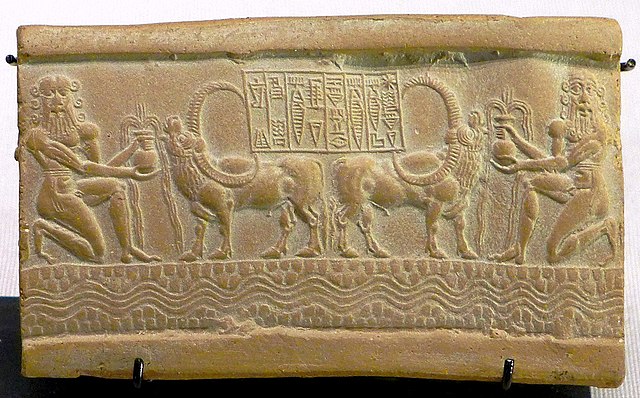
Impression
of a cylinder seal of the time of Akkadian King Sharkalisharri,
with central inscription :
Shar-kali-sharri da-num lugal a-ga-deki ibe-šarrum dub-sar
arad-su
"Divine Sharkalisharri, the mighty king of Agade, Ibni-Sharrum,
the Scribe his servant".
The long-horned buffalo is thought to have come from the Indus Valley,
and testifies to exchanges with Meluhha, the Indus Valley civilization.
Circa 2217-2193 BC. Louvre Museum.
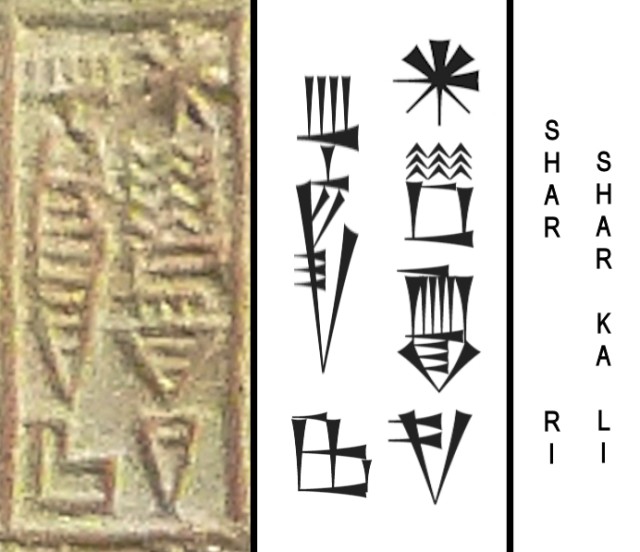
Akkadian
language cuneiform for Sharkalisharri. The star symbol, the "Dingir",
is a silent honorific for "Divine"
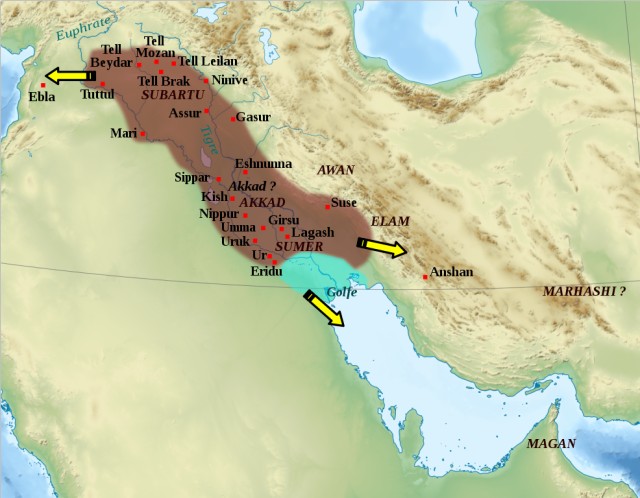
Shar-Kali-Sharri
fought to defend the borders of the Akkadian Empire, until it finally
collapsed
Rule
:
Succeeding his father Naram-Sin in c. 2217 BC, he came to the throne
in an age of increasing troubles. The raids of the Gutian hill peoples
of the Zagros mountains that began in his father's reign were becoming
more and more frequent, and he was faced with a number of rebellions
from vassal kings against the high taxes they were forced to pay
to fund the defence against the Gutian threat. Contemporary year-names
for Shar-kali-sharri of Akkad indicate that in one unknown year
of his reign, he captured Sharlag, king of Gutium, while in another
year, "the yoke was imposed on Gutium".
Year
names of Shar-Kali-Sharri :
Lists of year names can be found for many rulers from the time of
the Akkadian Empire, including Shar-Kali-Sharri. They shed light
on the length of his reign and the main events :
|
No. |
Particulars |
| 1. |
Year
in which became king of Agade |
| 2. |
Year
in which Szarkaliszarri having campaigned against
Sumer, in the mountains... |
| 3. |
Year
following the year Szarkaliszarri having campaigned
against Sumer, in the mountains … |
| 4. |
Year
in which Szarkaliszarri appointed Puzur-Esztar the
shagina (general), to build the temple of Enlil
|
| 5. |
Year
following the year Szarkaliszarri appointed Puzur-Esztar,
the szagina, to build the temple of Enlil |
| 6. |
In
the year in which Szarkaliszarri laid the foundations
of the temple of Enlil in Nippur |
| 7. |
Year
the foundations of the temple of Enlil (in Nippur)
were laid |
| 8. |
Year
following the year in which the foundations of the
temple of Enlil in Nippur were laid |
| 9. |
Year
the king Szarkaliszarri brought to the temple of
Enlil … |
| 10. |
In
the year in which Szarkaliszarri a vase of libation
in gold (for the temple of Enlil and) cut down cedar
timber for the temple of Enlil |
| 11. |
In
the year in which Szarkaliszarri laid the foundations
of the temples of the goddess Annunitum and of the
god Aba in Babylon and took prisoner Szarlag(ab)
the king of Gutium |
| 12. |
In
the year in which Szarkaliszarri was victorious
against Amurru |
| 13. |
In
the year in which Szarkaliszarri was victorious
over Amurru in the Djebel Biszri |
| 14. |
In
the year in which Szarkaliszarri was victorious
against Amurru |
| 15. |
In
the year in which Szarkaliszarri brought the battle
against Elam and Zahara in front of Akshak and …
and was victorious |
| 16. |
In
the year in which Szarkaliszarri was victorious
against Elam and Zahara |
| 17. |
Year
in which the yoke was imposed on Gutium |
| 18. |
In
the year in which Szarkaliszarri … |
| 19. |
In
the year in which Szarkaliszarri … Agade |
| 20. |
In
the year in which Enlil … … Szarkaliszarri
|
| 21. |
In
the year in which Enlil … Szarkaliszarri …
|
| 22. |
Year
Szarkaliszarri the king of Agade... |
|
23. |
In
the year in which Szarkaliszarri... |
|
- Regnal year names of Shar-Kali-Sharri
Submission of Sumerian kings :
.jpg)
Seal
impression of Lugal-ushumgal as servant of Shar-Kali-Sharri: "Sharkalisharri,
the mighty king of Agade, Lugalushumgal, ensi of Lagash, is thy
servant."
The submission of Sumerian rulers to Shar-Kali-Sharri, is recorded
in the seal inscriptions of Sumerian rulers such as Lugal-ushumgal,
governor (ensi) of Lagash ("Shirpula"), circa 2230-2210
BCE. Several inscriptions of Lugal-ushumgal are known, particularly
seal impressions, which refer to him as governor of Lagash and at
the time a vassal (arad, "servant" or "slave")
of Naram-Sin, as well as his successor Shar-kali-sharri. One of
these seals proclaims :
Shar-kali-sharri
da-num lugal a-ga-deki lugal-ušumgal ensi lagashki arad-su
"Shar-kali-sharri, the mighty king of Agade, Lugalushumgal,
ensi of Lagash, is thy servant."
-
Seal of Lugalushumgal as vassal of Shar-Kali-Sharri.
Loss of Lagash :
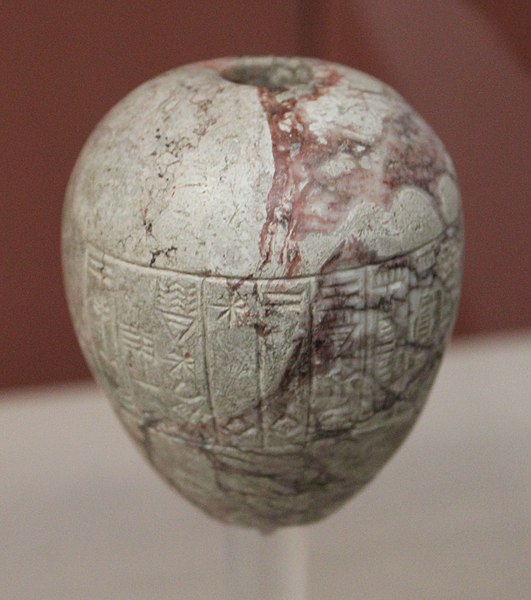
Ceremonial
macehead in the name of Shar-Kali-Sharri, in a dedication to the
temple of Shamash at Sippar: "Macehead dedicated to Shamash,
the Sun-God, by Shar-Gani-sharri, king of Agade". Anciently
attributed to Sargon of Akkad
Although Lugal-ushumgal, Governor of Lagash, proclaimed himself
as a vassal of Shar-Kali-Sharri, his successor Puzer-Mama took control
of Lagash during Shar-kali-sharri's reign, when troubles with the
Guti left the Sargonic king with only "a small rump state whose
center lay at the confluence of the Diyala and Tigris river."
Puzer-Mama started the 2nd Dynasty of Lagash.
Out
of the 24 years of his reign, names survive for some 18 of them,
and indicate successful campaigns against the Gutians, Amorites,
and Elamites, as well as temple construction in Nippur and Babylon.
Shar-Kali-Sharri reported defeating the Elamites at Akshak.
Fall
into anarchy :
Sumer also suffered from a terrible drought during Shar-Kali-Sharri's
reign in about c. 2200 BC, leading to the complete abandonment of
some cities. This is complementary to Egyptian records, which suggest
there was a drought around the same time during the reign of king
Pepi II. After Shar-Kali-Sharri's death in c. 2193 BC, Sumer fell
into anarchy, with no king able to achieve dominance for long. The
king list states:
"Then
who was king? Who was not the king? Igigi, Imi, Nanum, Ilulu: four
of them ruled for only 3 years."
Legacy :
The next recorded king of Akkad to rule for any reasonable amount
of time was Dudu, who is said by the king list to have reigned for
21 years. However, by this time the Akkadian empire was no more,
and Dudu most likely controlled no more than Akkad itself, meaning
Shar-Kali-Sharri was the last Akkadian king to actually have an
empire under his control.
In
the 1870s, Assyriologists thought Shar-Kali-Sharri was identical
with the Sargon of Agade of Assyrian legend, but this identification
was recognized as mistaken in the 1910s.
Inscriptions
:
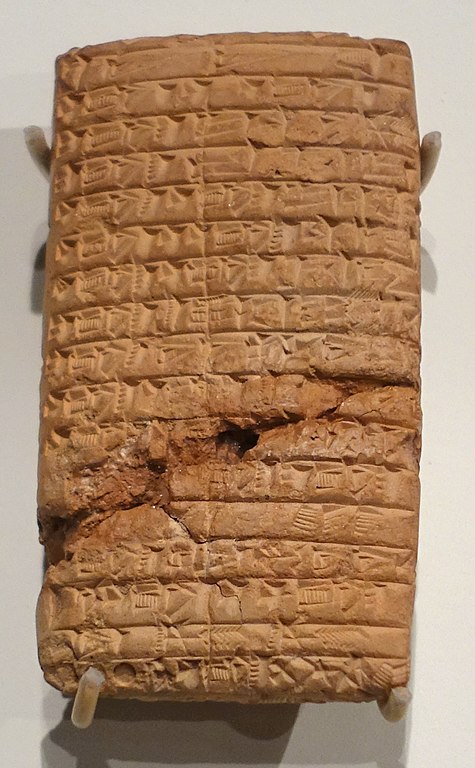
Tablet
in Akkadian language recording domestic animals, Bismaya, reign
of Shar-kali-sharri, c. 2100 BC, clay - Oriental Institute Museum,
University of Chicago
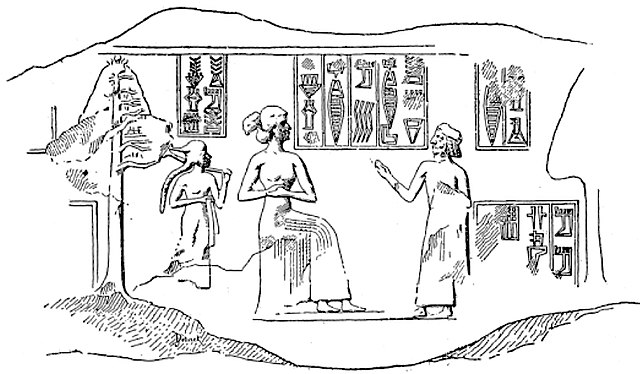
Seal
of Shar-Kali-Sharri (previously attributed to Sargon), with seated
deity
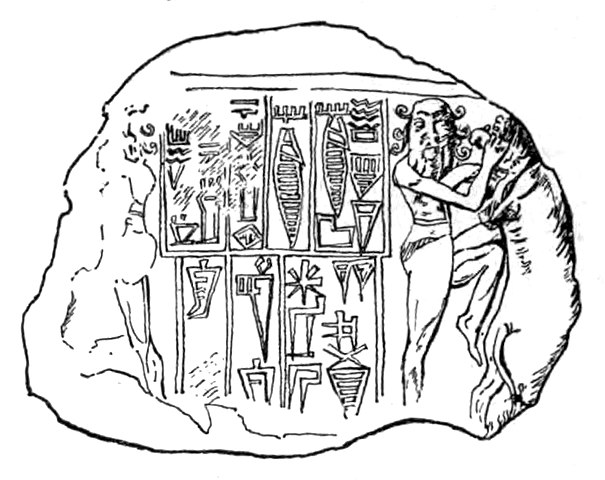
Seal
of Shar-Kali-Sharri (previously attributed to Sargon), with Gilgamesh
fighting a lion
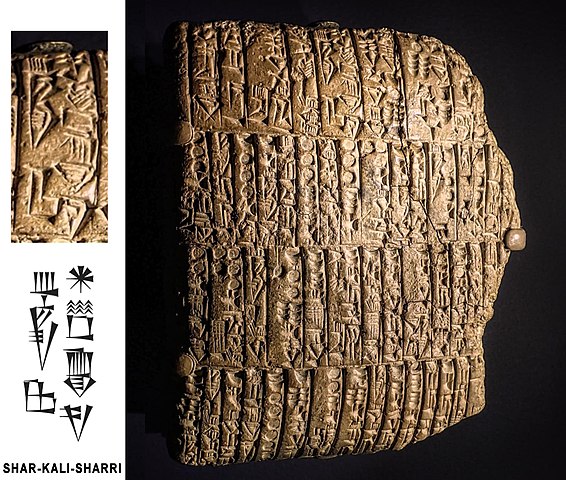
Cuneiform
tablet from Nippur, in the name of Shar-Kali-Sharri (4th column),
2300 - 2100 BCE
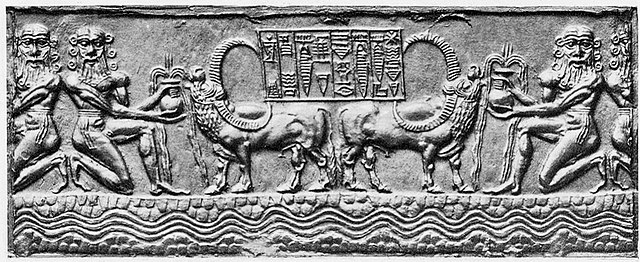
Shar-Kali-Sharri
seal
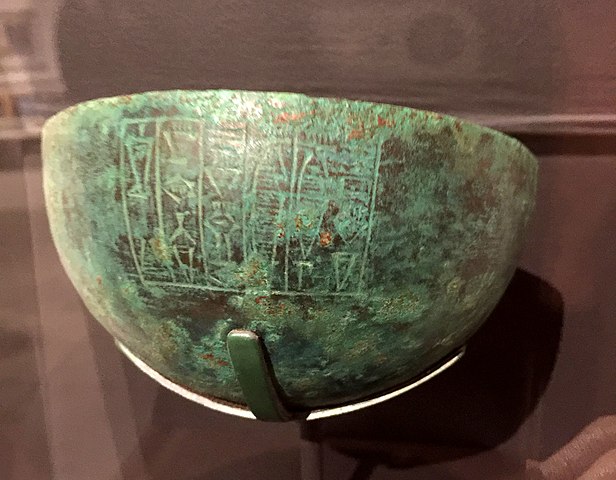
Bowl
with inscription "To Shar-kali-sharri, king of Agade, Shaki-beli
his servant.", Penn Museum
.jpg)
Brick
Stamp of Shar-Kali-Sharri (mirrored for readability). National Museum
of Iraq
Source
:
https://en.wikipedia.org/
wiki/Shar-Kali-Sharri




.jpg)







.jpg)